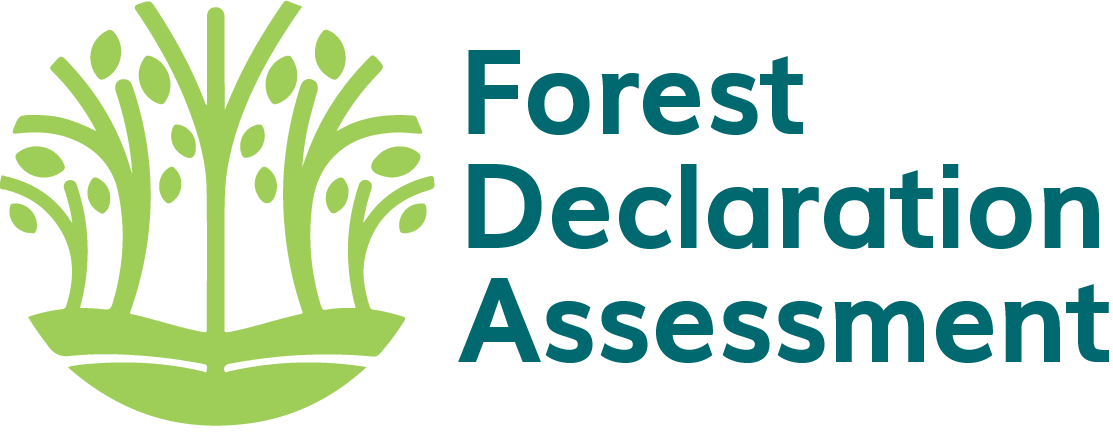Tropical Asia, led by Indonesia, is on track, but too many nations lag on meeting Glasgow forest promises
WASHINGTON DC (October 24, 2022)—Global deforestation decreased modestly by 6.3% in 2021, falling short of international goals of stopping forest loss and degradation by 2030 and limiting climate change to 1.5 degrees C, according to the Forest Declaration Assessment released today. Global gross deforestation amounted to 6.8 million hectares in 2021 — an area comparable in size to the Republic of Ireland — and generated 3.8 GtCO2e of associated GHG emissions.
One year ago, the United Nations (UN) climate change talks (COP26) in Glasgow saw a number of ambitious pledges for forests — notably, 145 governments signed on to the Glasgow Leaders’ Declaration aiming to halt and reverse forest loss and land degradation by 2030. But one year on, a lack of transparency on how related pledges are being met — such as reducing forest impacts from international trade and strengthening Indigenous peoples’ and local communities’ tenure rights — hinders both accountability and real progress.
The assessment (formerly the New York Declaration on Forests Progress Assessment), conducted by a coalition of civil society and research organizations, provides a dose of reality about the state and fate of these forests: not a single global indicator is on track to meet the 2030 goals of stopping forest loss and degradation and restoring 350 million hectares of forest landscape. Funding to protect and restore forests must increase by 200 times current levels to meet forest goals, and the best managers of forested land — Indigenous Peoples and local communities — remain excluded from decision-making, many financing opportunities and protections that ensure their territorial rights.
"Multiple streams of data show that the world is not on track to achieve our commitments to protect forests. We are quickly moving toward another round of hollow commitments and vanished forests," said David Gibbs, GIS research associate at Global Forest Watch, World Resources Institute.
“The world can’t let 2030 pass like the failed 2020 milestone of the New York Declaration of Forests.” said Franziska Haupt, managing partner at Climate Focus. ”Governments and the private sector must embrace bold reforms to value standing forests in proportion to their worth. And they must work together with civil society to accelerate forest action, supported by transparency and accountability.”
Exceptional progress in some countries shows that the 2030 goals are possible
The Forest Declaration Assessment is an independent, civil society-led initiative to assess progress toward the global goals of halting deforestation and restoring 350 million hectares of degraded land by 2030 as set out in international declarations like the New York Declaration on Forests (2014) and the Glasgow Leaders’ Declaration on Forests and Land Use (2021).
Using deforestation data from 2018-2020 to create a baseline, the assessment found that the decrease in global deforestation in 2021 did not match the pace needed to reach the 2030 goal to eliminate deforestation laid out in the Glasgow pledge. There has been exceptional progress by some countries, however. The assessment found that tropical Asia is the only region currently on track to halt deforestation by 2030, based largely on progress in Indonesia (the only country to lower its deforestation rate for each of the past five years) and its neighbor Malaysia.
In tropical Africa, Ghana and Côte d’Ivoire significantly reduced commodity-driven deforestation in 2021, while Uganda and Tanzania reduced deforestation overall. While deforestation rates in tropical Africa and Latin America decreased in recent years, those reductions are still insufficient to meet the 2030 goal.
Where progress has been made, the credit can be shared between government mandates and effective enforcement, bold and collaborative company action, and innovative efforts led by civil society and grassroots initiatives. Scaling up collaborative, mandatory action on forests can and has been effective at turning the tide on deforestation.
Indigenous peoples and local communities (IPs and LCs) stand at the forefront of protecting and safeguarding forests, in spite of the significant risks they face to do so. Securing their rights and ensuring direct access to finance is one of the most effective climate solutions that must be more widely embraced. Lands managed by IPs and LCs see overall better environmental and social outcomes than when outside organizations are in control of forests. Still, IPs and LCs are not adequately included in policy, and recognition and enforcement of their rights remain weak.
Forest cover increased in places -- but deforestation gains outweigh this progress
While global deforestation has continued apace, forest cover also increased by roughly 130.9 million hectares from 2000 to 2020 — an area slightly larger than that of Peru — with net gains in 36 countries. However, forest cover gains will never offset forest loss in terms of carbon storage, biodiversity and ecosystems services. The loss of primary forests cannot be replaced simply by reforestation or afforestation activities, according to the report. Forests that are currently intact need to remain intact.
The assessment stresses that forests are fundamental to regulating and re-stabilizing the global climate, with tropical forests playing a disproportionate role in this regard. Eliminating deforestation by 2030 is a major milestone for the Paris target because land use change, including deforestation and degradation, account for about 10-12% of global emissions.
“The Forest Declaration Assessment sends another warning signal that efforts to halt deforestation are not enough and we’re not on track to achieve our 2030 goals. There is no pathway to meeting the 1.5 degrees C target set out in the Paris Agreement or reversing biodiversity loss without halting deforestation and conversion. It’s time for bold leadership and for daring solutions to reverse this alarming trend,” said Fran Price, global forest practice lead, World Wildlife Fund.
200 times more funding for forests is needed
Less than 1% of the finance needed to protect and restore forests is currently being met. Currently, domestic and international mitigation finance for forests averages USD 2.3 billion per year, while the full total required is up to 460 billion per year.
IPs and LCs receive far less funding than their estimated needs for securing tenure rights and preserving the ecosystems in their territories — only 3% of need is being met annually.
Pledges made in 2021 demonstrate an increased ambition. If fully implemented, they would quadruple annual finance for forests, to USD 9.5 billion every year between 2021-25. However, this is still far from what is needed, and no information is yet available on how these pledges will be met.
“Governments, financial institutions, companies and philanthropies who make financial commitments must pair their marketing efforts on these pledges with transparency,” said Erin Matson, senior consultant at Climate Focus. “Right now, climate progress remains as illusory as climate funding, but transparency can provide an understanding of how far we have to go to get on the right trajectory and how quickly we have to move.”
Voluntary action not enough; mandates are needed to level the playing field for companies
Only a quarter of major global companies in the agriculture sector have announced a clear, comprehensive and ambitious policy to eliminate deforestation from their supply chains. Of those companies, fewer than 20% are close to meeting their commitments. The mining sector recently made strides by adopting policies and standards that address biodiversity impacts, but overall still lag significantly behind the agriculture sector.
Robust legal and policy instruments — such as moratoria, strengthened enforcement capacity, smart conservation policies and improved transparency and accountability — protect forests. The report notes as evidence the remarkable reductions in deforestation in various periods since 2004 when these tools have been employed in Indonesia, Ghana, Côte d’Ivoire, Gabon, Guyana, and Brazil. Yet, some of these achievements have been reversed — notably in Brazil —or are at risk of doing so, as countries phase out or roll back policy gains through recent and proposed amendments.
Recent legal reforms in major forest countries such as the Republic of Congo, Democratic Republic of Congo (DRC) and Peru have strengthened IP and LC rights recognition and protection. However, many major forest countries have also weakened the legal protection of IPs and LC rights through regulatory and legislative changes, and IPs and LCs still face violations of their rights and territories, as well as violence and marginalization.
“This report is another stark reminder that only eight years remain to meet 2030 global forest goals of halting deforestation and restoring degraded lands. Action from companies isn’t happening at the speed and scale that’s required to halt and reverse nature loss and limit global warming in line with the goals of the Paris Agreement. Building momentum requires more and better disclosure from companies and the right signals and incentives from governments, from investors and from consumers,” said Thomas Maddox, global director, forests and land, CDP.
“Since our first assessment in 2016, we've seen little progress in removing deforestation from corporate supply chains,” noted Franziska Haupt. “The potential of voluntary company action has not yet been realized, but we've seen success where strong governance meets genuine company effort through aligned, inclusive and collaborative action. That's where the rubber meets the road and we can finally change the global trajectory toward the 2030 forest goals.”
# # #
Read the 2022 global Forest Declaration Assessment here: "Forest Declaration Assessment: Are we on track for 2030?"
A series of four reports on Overarching forest goals (Theme 1), Sustainable production and development (Theme 2), Finance for forests (Theme 3), and Forest governance (Theme 4).
###
For more information, contact:
Ellen Wilson, +1 301-466-3205 or [email protected]
Susan Tonassi, +1 202-716-9665 or [email protected]



